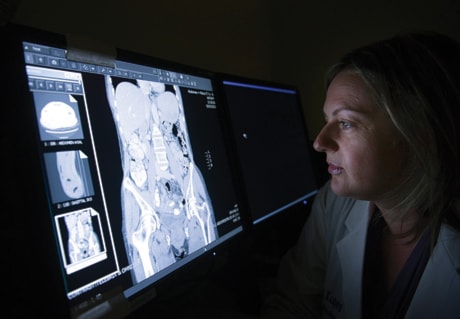TORONTO — One-quarter of women whose Pap smears showed abnormalities didn’t get the followup that would be expected within two years of the test, an examination of more than 40,000 screenings has revealed.
It’s a startlingly high number in a world where women repeatedly hear the message that they should get regular Pap tests because the prognosis is better if cervical cancer is detected early.
Pap smears don’t pick up cancer, but they can identify precancerous cells or lesions on the cervix which can be easily treated so they don’t develop into cancer.
The fact that 26 per cent of the 43,792 Ontario women whose records showed abnormalities between 2000 and 2005 didn’t have any followup may indicate a breakdown in communications, says lead investigator Dr. Rachel Kupets, a gynecologic oncologist at the Odette Cancer Centre at Sunnybrook Health Sciences Centre in Toronto.
“I think it’s a high number. It needs to be improved and it will be improved,” she said in an interview.
“Looking at our study, we know that about three per cent of these women will actually have a cancer on their cervix ... and those women who actually have a cancer on their cervix in an early stage may progress to a more advanced stage, making it more difficult to treat.”
Women need to phone their doctor’s office for test results, understand them and be proactive about their own care, she advised. And doctors need to have a process in their clinics to capture all the abnormal results, contact individual patients, explain results and ensure followup appointments are scheduled, she said.
Kupets called for a centralized body to oversee cervical cancer screening, which would include recalls when there are abnormal results — something which already exists in a number of other provinces.
The study also recommends developing consistent language for pathology reports and quicker appointments for followup investigative tests such as colposcopy, a procedure in which a magnifier is used to assess the cervix so that fine details in anatomy and blood vessels can be seen.
Kupets’ article with co-author Lawrence Paszat is published in the June issue of the journal Gynecologic Oncology.
“The best way to prevent cervical cancer is obviously to get a Pap smear, but we also know that women who have Pap smears can also get cervical cancer, and we wanted to know why that is,” said Kupets, an assistant professor at the University of Toronto.
One reason could be that followup is somehow compromised, she said, and the findings seem to bear this out.
“I didn’t want the study to come off pointing fingers at anybody. I think it’s important to say that patients and physicians have to work together to make the system work,” Kupets said.
“It is possible that the physician sees the result, calls the patient, discusses the result with the patient, schedules appropriate followup, but the patient does not follow up with the care that is recommended.”
A centralized body for screening could identify women who have not had followup care for abnormal pap smears. “(It) notifies their physician, saying: ‘What happened to Mrs. X? She’s not had any followup despite having a severe abnormality,”’ Kupets explained.
Dr. James Bentley, past-president of the Society of Canadian Colposcopists, said procedures vary from province to province.
“In Nova Scotia where I am, if I take a Pap test of somebody and there’s a high-grade change, and the registry does not tag that they’ve had a colposcopy done within a certain length of time ... I get a letter reminding me about that,” Bentley said from Halifax.
Bentley said that theoretically, it could be a bigger problem in Ontario than in some other locations.
But getting patients to come in for testing is always a challenge, he noted. “Some people will get very anxious with an abnormal Pap test, and understandably, and will do exactly what you tell them to.
“Some people will not because they don’t actually have a symptom, they don’t have a problem. They don’t come in appropriately. And they’re often young people that are busy.”
Colposcopy is done with the patient awake, much like a Pap test, and abnormalities or pre-cancerous lesions can be treated in a variety of ways: cryotherapy, or freezing; laser therapy to burn off the area of the cervix with an abnormality; or the loop electrosurgical excision procedure, or LEEP, in which a thin wire carrying an electrical current is used to shave off a little piece of the cervix.
Kupets said one treatment is usually 80 to 90 per cent effective in getting rid of any precancerous cells on the cervix.
Dr. Sheila Dunn, a family doctor at Women’s College Hospital in Toronto, noted that the 26 per cent figure for women not getting a followup dates back a few years, so the situation could be different now.
“The College of Physicians and Surgeons has new guidelines around ensuring that doctors, if you order a test, you’re responsible for making sure you get that test back and do the appropriate followup,” she said.
“Those are sort of very new policies that have come into place so that people are being more rigorous about tracking.”
Dunn said she believes that electronic medical records in family physicians’ offices will help ensure that if someone doesn’t get referred or misses an appointment, it will be easier to track.
Cancer statistics indicate an estimated 1,400 new cases of cervical cancer are diagnosed in Canada each year, and an estimated 400 women die annually from the disease.
“People might say that’s not many cancers, but we do a lot of screening and a lot of colposcopy and a lot of followup to actually get it down to those low levels,” Bentley said. “That’s the importance of the Pap test.”
